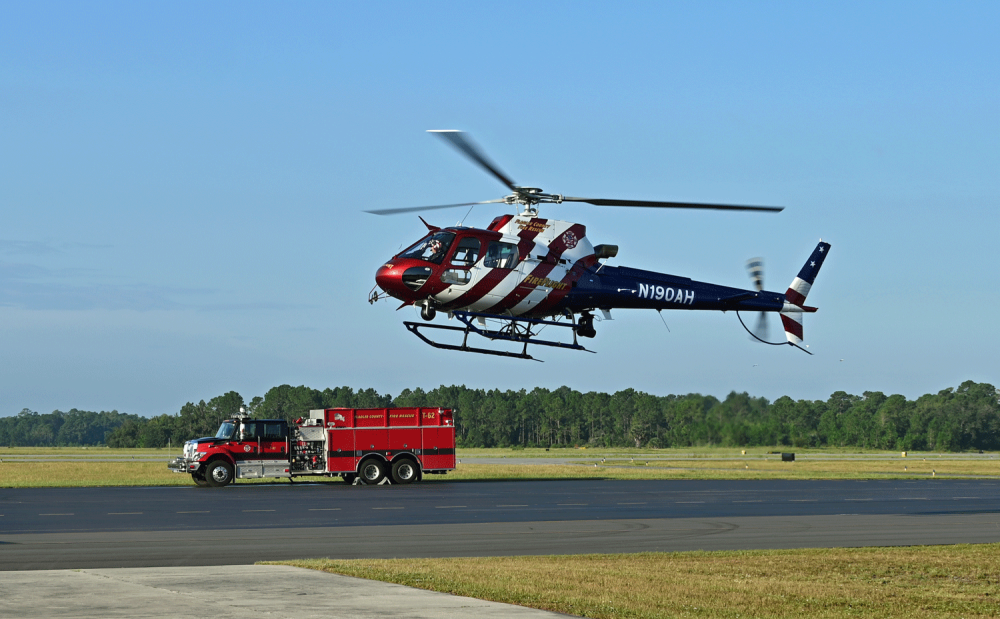
At 8:50 Wednesday morning, FireFlight lifted off from near its hangar at the Flagler County Airport for the last time. Flight Operations Chief Todd Whaley, who was at the controls, tipped the nose of the chopper a couple of times in the direction of the crowd of officials and others who’d turned out for the decommissioning.
Whaley then turned the bird and flew it through an arc of water spraying from two firetruck’s cannons as a dispatcher enumerated its accomplishments in 22 years of service for the county: almost 800 patients flown to trauma centers, 851 wildfire suppression missions that included dropping over 2 million gallons of water and foam, countless wildfire reconnaissance missions, 282 searches for lost individuals, 764 law enforcement missions.
Now it was on its way to Sanford to be disassembled for parts, like an organ donor. It was sold to HeliWelders, a helicopter maintenance company, for $650,000 dollars.
Dana Morris had come out of retirement in Colorado to watch the decommissioning with his old crew. It was his helicopter, after all. He’d flown it for its entire existence, before he worked for the county. “It’s part of me,” he said, not without some emotion, especially when he thought about the disassembling. “That’s going to hurt.” He was hoping there might be a chance for the helicopter to be sold to a utility company for low-risk work. An enormous replica sits encased in glass at his home in Colorado, a retirement gift from Flagler County.
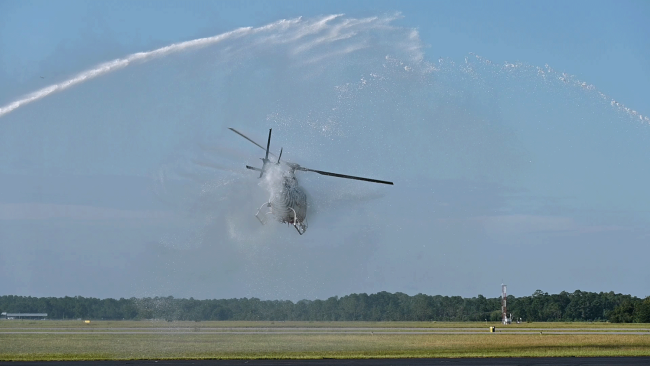
It wasn’t just a decommissioning, of course. It was the simultaneous commissioning of the new FireFlight, a $5.6 million helicopter, same make, similar design, with more than two decades’ improvements. That helicopter rose moments after the older one did and flew in formation a long distance toward the southwest before returning and–once the old helicopter would have landed in Sanford–assuming the old N number that Flagler County owns: N911US.
Fire Chief Michael Tucker and others unveiled the number on the tail of the new helicopter as part of the ceremony. “Does it smell like a new car inside?” County Commission Chair Andy Dance asked.
Palm Coast Mayor David Alfin couldn’t resist: “That’s Palm Coast blue on the tail, right?,” perhaps forgetting that the Palm Coast city manager and council in 2001 had opposed the county’s helicopter purchase. (“One spoilsport is determined to cut the victory lap short: Palm Coast,” the News-Journal editorialized at the time, after the City Council unanimously voted against the buy.)
Grumbles about cost have failed the new purchase as well, but only from residents. “As I’ve told people that were raising questions about the purchase of the helicopter during the campaign, I think it’s the single most important life safety device that we can have,” Dance said, citing the helicopter’s various uses.
In 1998 Flagler County became the only county in state history to get a full, mandatory evacuation order because of wildfires that destroyed 74 homes and damaged 147. The County Commission approved buying the 1998 Eurocopter AS-350 B3 on Aug. 6, 2001. It cost $1.1 million, plus $4000,000 to transform it into a firefighting unit with the 216-gallong Bambi Bucket, and as an air ambulance. Morris had been flying the same helicopter in Yosemite National Park for two years, in firefighting and search-and-rescue missions. He flew it into Flagler County for what was to be a two-week stint. He stayed 20 years until he retired in 2022, after over 12,500 flight hours.
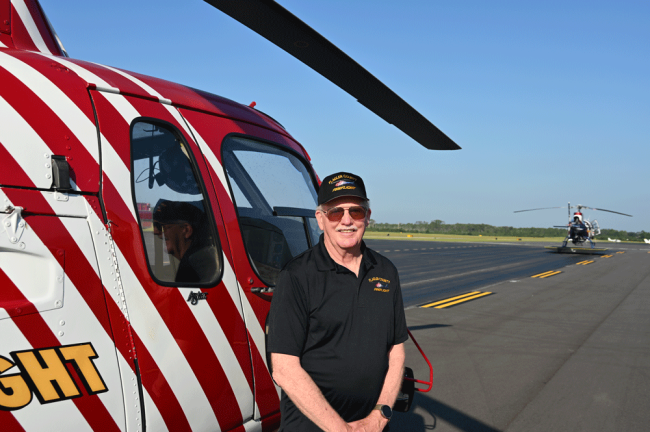
At 24 years, 22 of them in Flagler County, the old FireFlight was the oldest helicopter of its kind still flying in the United States.
“That’s a testament to Todd Whaley, our director of flight operations and director of maintenance,” Tucker said. “He is a mechanic, and he is one of our pilots as well. That’s unique for us to have. There’s not many other people that do that. So Todd works on the helicopter all the time, and he just takes immaculate care of it.” But the helicopter was causing increasing maintenance issues. It was no longer worth the continuing repairs.
The new helicopter has more power, more lift, which will help when it pulls the 216-gallon bucket of water out of ponds when fighting wildfires. It’s roomier for medics to work when the helicopter is transporting a patient to hospital. It has a newer infrared camera system for search while assisting law enforcement or for search-and-rescue operations. It also frees the pilot from having to navigate by sight when looking for an address. The GPS system locks onto an image and guides the helicopter there. It’ll require less maintenance, and it has a 10-year warranty.
“We get to the fires quicker. We keep them small, so they don’t become big, and we don’t have another 1998 or 2000,” Tucker said. “It also keeps the firefighters out of the woods, which is a very dangerous place for firefighters to be in a wildfire. It’s not safe at all. I’d rather fight a house fire than a wildfire. Believe it or not, that’s a safer environment than being in the woods.” No occupied home has been lost to a wildfire since the county bought FireFlight.
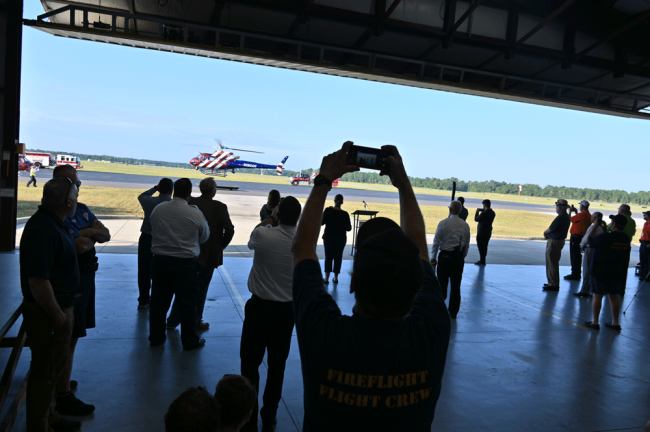
So why hasn’t FireFlight become a 24-hour operation, instead of the 8 a.m. to 8 p.m. operation it’s been for a decade and a half? “It’s a budget issue,” Dance said. “I think with a new helicopter, it makes a lot of sense” to go 24 hours. “It’s been a discussion point the last couple of years. So really, it’s just part of the priority process through budgeting that needs to be looked at.”
Those discussions will start in December. “A lot of it probably depends on how we’re going to be funding other things, such as infrastructure, beach erosion and stuff like that,” County Administrator Heidi Petito said. “The general fund dollars has competing challenges. Public safety is definitely paramount.” But Flagler County Fire Rescue is looking to add firefighters, as well.
Tucker says he’s “100 percent interested” in going to a 24-hour operation. “Anytime we can serve the citizens better is something we’re in favor of doing,” he said. “After eight o’clock at night right now, we have to rely upon helicopter services to the north or helicopter services to the south. Sometimes they’re on their own emergencies, because they’re busy as well, and then we have to wait for helicopters to come from even farther away to come in. So having a 24-hour operation allows us to take care of our people when we need to.”
The county’s FireFlight division, “Flight Operations,” is a $900,000 operation, according to next year’s proposed budget, with $408,000 of that in personnel costs and $500,000 in operational costs. Insurance alone is $100,000. Maintenance is $137,000. Fuel is $58,000. A 24-hour operation would increase personnel costs significantly, but operational cost would not increase as much. The helicopter also generates some revenue from transporting patients–about $12,000 per flight.
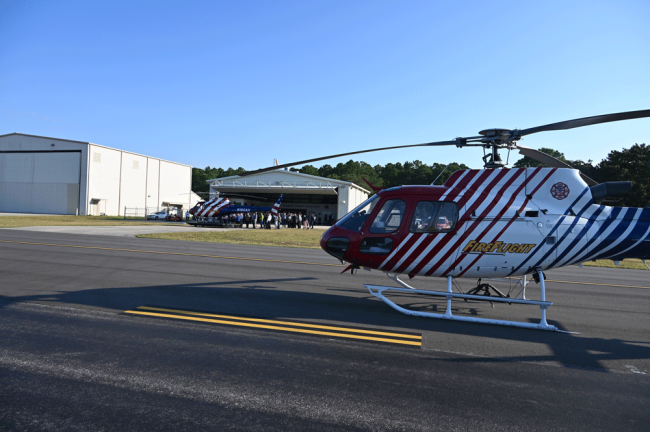
As the two helicopters prepared to take off, one for its last flight, the FireFlight Crew stood in a tight row between the two. Morris joined the crew. “That’s what I miss in retirement, is the camaraderie of firefighting,” he said. But he was awed b the new machine, describing it as going from a Ford Focus to a Mercedes. In the hangar, mingling with the officials and others, was Roy Longo, who retired in 2019 as a medic after 30 years of service, including over 500 missions on FireFlight, many of them with Morris.
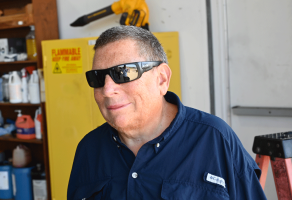
“I remember one particular crash in Seminole Woods. Dana Morris was the pilot and I was the flight medic,” Longo said. “We flew the patient to Halifax but on the way back a rain storm prevented us from returning to Flagler County. Dana decided to wait out the storms at Ormond Beach Municipal Airport, but a storm prevented that, so he decided to go to Putnam County Airport. As we were flying west the storms at Flagler County and Ormond Beach built up quickly and we squeezed in between them, which caused significant turbulence. Because of Dana’s skills we were never in any danger, but it was quite the wild ride.”
They couldn’t make it to Putnam. Luckily for them, a Flagler County employee lived on about 10 acres off of County Road 302. Morris landed there. “The employee’s two toddlers were home with his wife and the kids were ecstatic to see FireFlight landing on their property. We waited inside the house until we could return to the airport. Dana had thousands of hours in helicopters and I doubt this trip phased him one bit. I was new on FireFlight and it was one of the more exciting flights I ever had. I never felt unsafe with any of the
pilots, but Dana was far and above the best pilot Flagler County has ever had.”
![]()
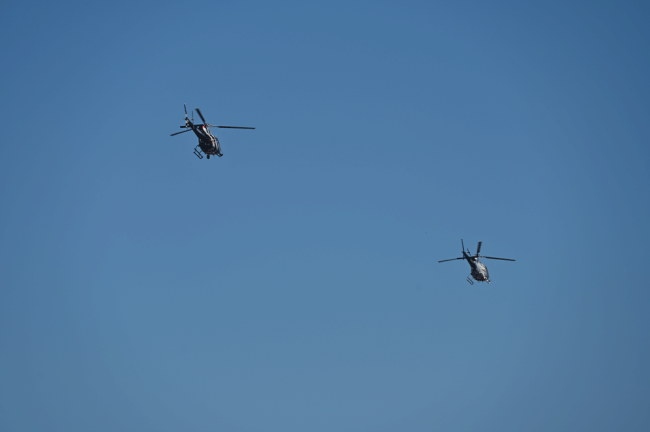





























tulip says
It should be a 24 hour service. Accidents don’t just happen on a schedule. It’s very unnerving to know that if you have a serious accident “after hours of operation” there is no help to depend on . I understand that other counties share their helicopters, but they too have accidents where they are and it could be in use when another county needs it as well.. They way this city has grown perhaps we should have two of them.
Skibum says
Wow, a remarkable testament to the knowledge, skill and dedication of those professionals at FireFlight to hear that the oldest helicopter of that type in the entire nation made it safely to retirement after more than 20 years of service here in Flagler County. I am very pleased that we now have a newer, more powerful, and better equipped helicopter for use in all types of emergencies. The next best news report about our county’s FireFlight helicopter will be when the county commissioners finally agree to make this critical resource a 24-hour, 7-day a week emergency response service.
Joe D says
As a retired nurse at an internationally recognized East Coast Trauma Center, expanding from 12 hr coverage, to 24 hour coverage is a significant increase in expenses. That being said, as the Palm Coast population increases, and with the trauma limitations of our local Community Hospitals, there will likely soon come a time where 24 hr service is required.
I would imagine there are records of how many calls have been needed (and emergency transfers delayed) after 8 pm, who had to respond to them from outside our area …and the cost to the County to obtain outside services. There might be other statistics on the number of life threatening COMPLICATIONS occurring due to DELAYS in trauma transportation to outside trauma centers…essentially PEDIATRIC traumas.
The County might want to conduct a study of the cost/benefits of a 24 hr service expansion…and the possibility of SHARING the pilot and flight staff on call schedules among several local jurisdictions to reduce duplication of staff salaries between emergency flights, and reduce the total costs.
Jane Gentile Youd says
Sorry I missed the final farewell to Fire Flight on Wednesday. (I still have the article from June 2013 when then Chief Don Petito, for various reasons, stopped the then 24 hour service – I was infuriated and complained ( obviously to no avail)
The undersigned has been asking the commissioners, at budget workshops and meetings for YEARS upon years in person to have our helicopter available 24/7.
Our population has doubled since the former 24/7 service was cut and our county has doubled in population. Now we have a brand new helicopter with a big mortgage, Doesn’t make any sense to spend money on a mortgage but not on extra staff ready in a split second and never stick her into a closet for one minute!
Great news that Chief Tucker and Chair Andy Dance both are aware that the time has come – and is actually way overdue – to keep ‘her’ ready 24/7 . Makes me happy that we will be so much more secure once ‘she’ is ready
Roy Longo says
I don’t believe the Fire Chief has the authority to change the hours of the helicopter. I believe that falls under the authority of the County Commission.
FlaglerLive says
Roy Longo is correct.
Jane Gentile Youd says
I am well aware the county commission decides on the Fire Chief’s budget and I have asked the commission, for years, to increase his budget. I asked the Chief how much he felt he needed 2 years ago and he responded via email ” around $300,000. The Commission denied my many workshop requests. It is all on you tube